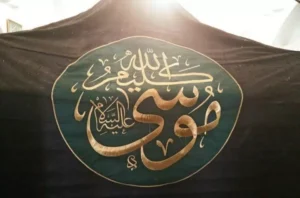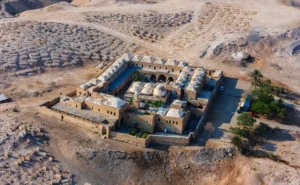The Maqam (or Shrine) of Prophet Musa (upon him be peace) is a significant Islamic site believed to be the resting place of Prophet Musa (Moses), who is revered in Islam as one of the greatest prophets sent by Allah. Here is a detailed overview of the maqam, its location, significance, and history:
Location
The Maqam of Prophet Musa is located in the Judean Desert, approximately 11 kilometers south of Jericho and about 20 kilometers east of Jerusalem in the West Bank, Palestine. Nestled amidst arid landscapes, this site has long been a destination for pilgrims and visitors seeking spiritual reflection and connection.
Significance
- Prophet Musa in Islam:
- Prophet Musa (upon him be peace) is one of the most frequently mentioned prophets in the Qur’an, with his story emphasizing steadfastness, trust in Allah, and liberation from oppression.
- He is celebrated for leading the Children of Israel out of Egypt and receiving the Torah (Tawrah) on Mount Sinai.
- Spiritual Importance of the Maqam:
- The maqam serves as a place of veneration and reflection on Musa’s life, teachings, and unwavering faith in Allah.
- It is believed that this site was chosen divinely for his burial, although Islamic traditions also mention his desire to be close to the Holy Land.

Historical Background
- Origins:
- The exact location of Prophet Musa’s burial remains uncertain. The Qur’an does not specify his burial site, but Islamic traditions point to this region, fulfilling his wish to be near the “Blessed Land” (al-Ard al-Muqaddasah).
- Construction:
- The current maqam complex was built in the 13th century during the reign of the Ayyubid Sultan Al-Malik al-Mu’azzam. It was later expanded by the Mamluks.
- Architecture:
- The maqam is a magnificent structure with a mosque, minaret, large courtyard, and domed chambers. The simplicity of its design reflects the spiritual nature of the site.
- Annual Pilgrimage:
- Historically, a pilgrimage known as the Nabi Musa Festival was held, attracting thousands of Muslims. This tradition symbolized communal unity and reverence for the Prophet Musa.
Cultural and Religious Insights
- Verses in the Qur’an:
- Musa’s pivotal role in guiding his people and facing Pharaoh’s tyranny is recounted in numerous Qur’anic chapters, including Surah Al-Baqarah, Surah Taha, and Surah Al-Qasas.
- Lessons from Musa’s Life:
- Patience and perseverance in adversity.
- Trust in Allah during challenges, exemplified in the splitting of the Red Sea.
- Leadership based on faith, compassion, and justice.
- Prophetic Connection:
- Visiting the maqam offers an opportunity to reflect on the trials faced by Musa and to draw inspiration for overcoming personal challenges with faith.
Modern-Day Relevance
The maqam remains a vital site for Islamic history and culture:
- It is preserved as a heritage site, attracting pilgrims and tourists worldwide.
- Efforts are ongoing to maintain the site’s sanctity and to promote understanding of its religious and historical importance.

Abu Hurayrah (رضي الله عنه) narrated that the Prophet (ﷺ) said:
The Angel of Death was sent to Musa (عليه السلام). When the angel approached him, Musa (عليه السلام) struck him on the eye. The angel returned to Allah (ﷻ) and said, ‘You have sent me to a servant who does not wish to die.’ Allah (ﷻ) then commanded the angel, ‘Return to him and tell him to place his hand on the back of an ox. For every hair under his hand, he will be granted one year of life.’
Musa (عليه السلام) asked, ‘O Lord, what will happen after that?’ Allah (ﷻ) replied, ‘Then death.’ Musa (عليه السلام) said, ‘Let it be now.’
He then requested Allah (ﷻ) to let him die near the Sacred Land (close to Masjid al-Aqsa), at a distance where he would be just a stone’s throw away from it.
Abu Hurayrah (رضي الله عنه) added that the Prophet (ﷺ) said, “If I were there, I would show you his grave beneath the red sand hill by the side of the road.
How to Visit
Visitors typically reach the Maqam from nearby cities like Jerusalem or Jericho. The journey through the Judean Desert provides a serene and spiritual experience. It is advised to check current travel conditions and local guidelines due to the sensitive nature of the region.
Video Maqam of Prophet Musa (upon him be peace)
Conclusion
The Maqam of Prophet Musa is not just a physical monument but a symbol of faith, perseverance, and divine guidance. Visiting this maqam allows believers to connect with one of the most profound stories of human resilience and submission to Allah’s will. It serves as a reminder of Musa’s enduring legacy in the hearts of millions across generations.



![[PHOTOS] Hijrah 1447: Sacred Ceremony of Kaabah’s New Cover Unfolds in Mecca [PHOTOS] Hijrah 1447 - Sacred Ceremony of Kaabah’s New Cover Unfolds in Mecca](https://islamreligionguardian.com/storage/2025/06/PHOTOS-Hijrah-1447-Sacred-Ceremony-of-Kaabahs-New-Cover-Unfolds-in-Mecca-2-218x150.jpg)

